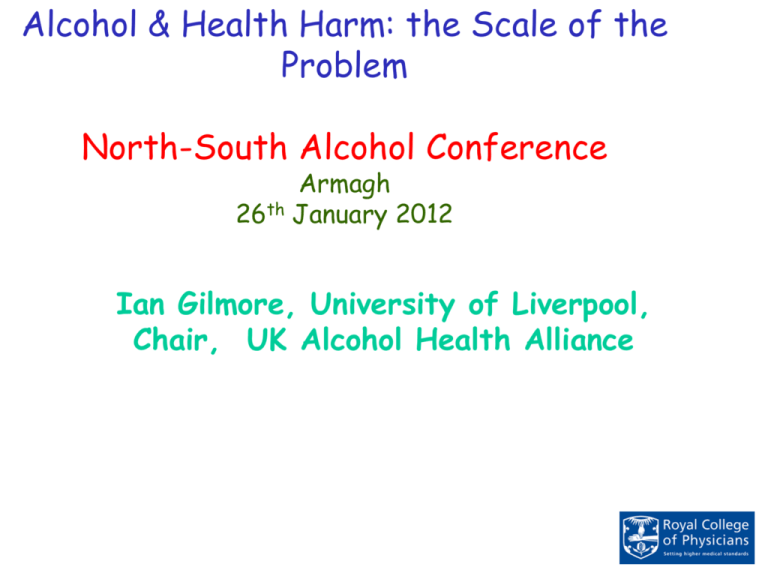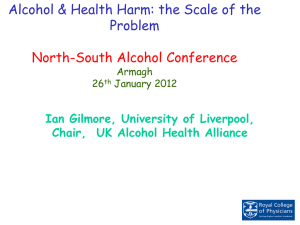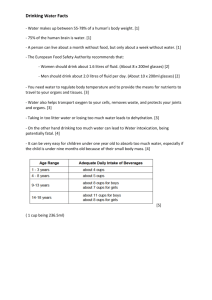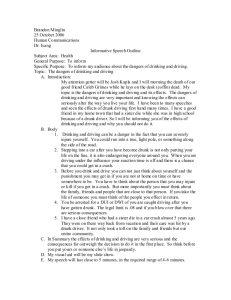Microsoft PowerPoint (Alcohol health impacts)
advertisement

Alcohol & Health Harm: the Scale of the Problem North-South Alcohol Conference Armagh 26th January 2012 Ian Gilmore, University of Liverpool, Chair, UK Alcohol Health Alliance WHO Global Status Report 2011 Why is per capita consumption apparently falling? • number of abstainers in UK is increasing • average consumption per non-teetotal adult = 25 units/wk • increase this by 15% for unrecorded / consumed abroad Abstainers in last 12 months (% of adult population) China –the new global market for alcohol Recorded adult per capita consumption age 15+– (unrecorded 1+l/person) Illicit and ‘informally produced’ alcohol • 27% alcohol consumption worldwide unrecorded (WHO) • varies across the world: o slovenian wine mainly unrecorded o one-third consumption in Russia unrecorded o two-thirds consumption in India ,, o 90% consumption in East Africa ,, • average Ukranian consumes 8 litres unrecorded alcohol per annum Drinking with meals in the EU 15 Source Eurobarometer 2003 WHO Global Status Report 2011 ESPAD data on amount drunk by 15-16 yr-olds on last drinking occasion ESPAD 2007 ESPAD data on % 15-16 yr-olds who had been drunk in last year ESPAD 2007 Consumption and young people Good news and bad news……. •Fewer 11-15 year olds admit to having drunk alcohol in the UK •However those that do are drinking more Drinking to unwind after stressful day….. Of women that drink hazardously - 81% do so to relieve stress Know Your Limits/YouGov; Netmums, 2008 Women and alcohol • Advertising and marketing – more sophisticated and more aimed at women Pre-loading DALYs lost attributable to 10 leading risk factors for the age group 15–59 years in the world, 2004 WHO Global Status Report on alcohol and health 2011 Global distribution of alcohol-attributable deaths and DALYs by broad disease and injury categories, 2004 WHO Global Status Report 2011 Alcohol Related Admissions for Liverpool PCT (residents) 2002/03 to 2008/09 by Condition Group. 3500 Rate per 100,000 3000 2500 CHRONIC CONDITIONS 2000 Chronic Conditions Rate Wholly Attributable Rate 1500 Acute Consequences Rate 1000 DEPENDENCE 500 0 2002/2003 2003/2004 2004/2005 2005/2006 2006/2007 2007/2008 2008/2009 Male alcohol-related deaths by age group, England Jones et al, NW Public Health Observatory Report 2008 patterns of drinking and harm Binge drinking •The consequences of getting drunk: • Violence, accidents • STD’s, sexual mishaps Regular drinking •the consequences of repeated heavy exposure • Cirrhosis • Other physical damage • Psychosocial harms But note that these patterns are not mutually exclusive Patterns of drinking and harm Pattern of drinking (adjusted for total consumption) and mortality risk Kauhanen et al, BMJ, 1997 Liver cirrhosis mortality rates in Europe • up to 20-fold differences between countries (range 4/100,000 for Icelandic males, 75/100,000 for Hungarian males) • rates tend to be much higher in East than West Europe, particularly in under 45 years • male female ratio across countries very constant, men being 2-3x higher • liver mortality correlates with other alcohol-related deaths, especially in <45 yr age group Differences in standardised mortality rates over the last decade – ages 15-44 (%) Men Women Scotland 227 170 England & Wales 224 185 Ireland 135 160 France 91 66 Spain 69 57 Italy 76 57 Leon and McCambridge, Lancet 2006 Sheron 2010, Projections for UK liver deaths Lancet 2011 Countries with markedly rising cirrhosis rates in last twenty years • • • • • • • • Bulgaria Denmark Estonia Finland Baltic countries Poland Russia UK + Ireland Tend to be: • Northern and Eastern European • Beer/spirit drinking • Binge pattern • Starting from lower levels Countries with markedly falling cirrhosis rates in last twenty years • • • • • • • Austria France Germany Greece Italy Portugal Spain Tend to be: • Southern European • Wine drinking • With meals • Starting from high levels Passive drinking The situation in Republic of Ireland • consumption stands at 10.9 litres per capita, despite 19% abstainers • 25% of Irish men report bingeing at least once per week • half of Irish drinkers do so in a harmful pattern • there has been a shift from pub to home drinking • alcohol remains a huge risk factor for ill-health, relationship breakdown, hospital admission, suicide and and death from other causes. Age-standardised alcohol-related death rates by deprivation* twentieth and sex, England and Wales 1999-2003 Least deprived * Carstairs deprivation index Most deprived Why is alcohol such a large health inequalities issue? • Mean consumption across the social scale similar • Is it under-reporting? • Is it another factor eg obesity? • Is it the distribution of drinking patterns? Drinking type by annual household income quintile, 2008 Three decades of evidence • Alcohol control policies in public health perspectives –Bruun et al , 1975 • Alcohol policy and the public good – Edwards et al 1994 • Alcohol: no ordinary commodity – Babor et al 2003 and 2010 Competing frameworks for alcohol policy •Alcohol is normal • Problems arise when a minority of people misuse it ( “spoil it for the rest of us) • Therefore the solution is to change the behaviour of the minority (“target other people“) through education and “culture change” (Industry paradigm) •Alcohol is not an ordinary product • The problem is not with the individual but the product • Therefore the solution is to make the environment less pro-alcohol and reduce the population consumption • The maximum health gain is through shifting the consumption curve left (“everyone’s problem”) (Public health paradigm) (from Evelyn Gillan, Alcohol Focus Scotland) International evidence to ‘shift the curve’ and maximise health gain: • availability • promotion by the alcohol producers and retailers • price of alcohol Impact of a 50p minimum unit price • Research into the effect of a 50p minimum price per unit shows for every year (England): • 3,393 fewer deaths • 97,900 fewer hospital admissions • 45,800 fewer crimes • 296,900 fewer sick days • And a total saving of £15 billion over ten years (health, crime, social care.) • Source: Chief Medical Officers Report 2008, Meier 2009 Final thoughts….. •Alcohol use is legal and firmly embedded in our society and will remain so. • The cardiovascular benefits, if real, are seen at very low consumption levels, affect only the middle aged + and are not a reason for non-drinkers to drink • Health and other harms are a major societal issue and are not confined to those who obviously misuse alcohol. • We need to better understand the links to low socioeconomic status Final thoughts… (2) • While the relationship between population consumption and harm are not perfect, the maximum health improvements will be seen through shifting the whole consumption curve downwards • Individuals may choose to live with different levels of risk associated with their pattern and volume of consumption, but must be provided with good information on those risks. This is not currently possible • Within those who ‘choose’ to drink at higher levels there will will be many with a degree of dependence on alcohol who are not exercising ‘free will’, and we need to get better at identifying and helping them.







